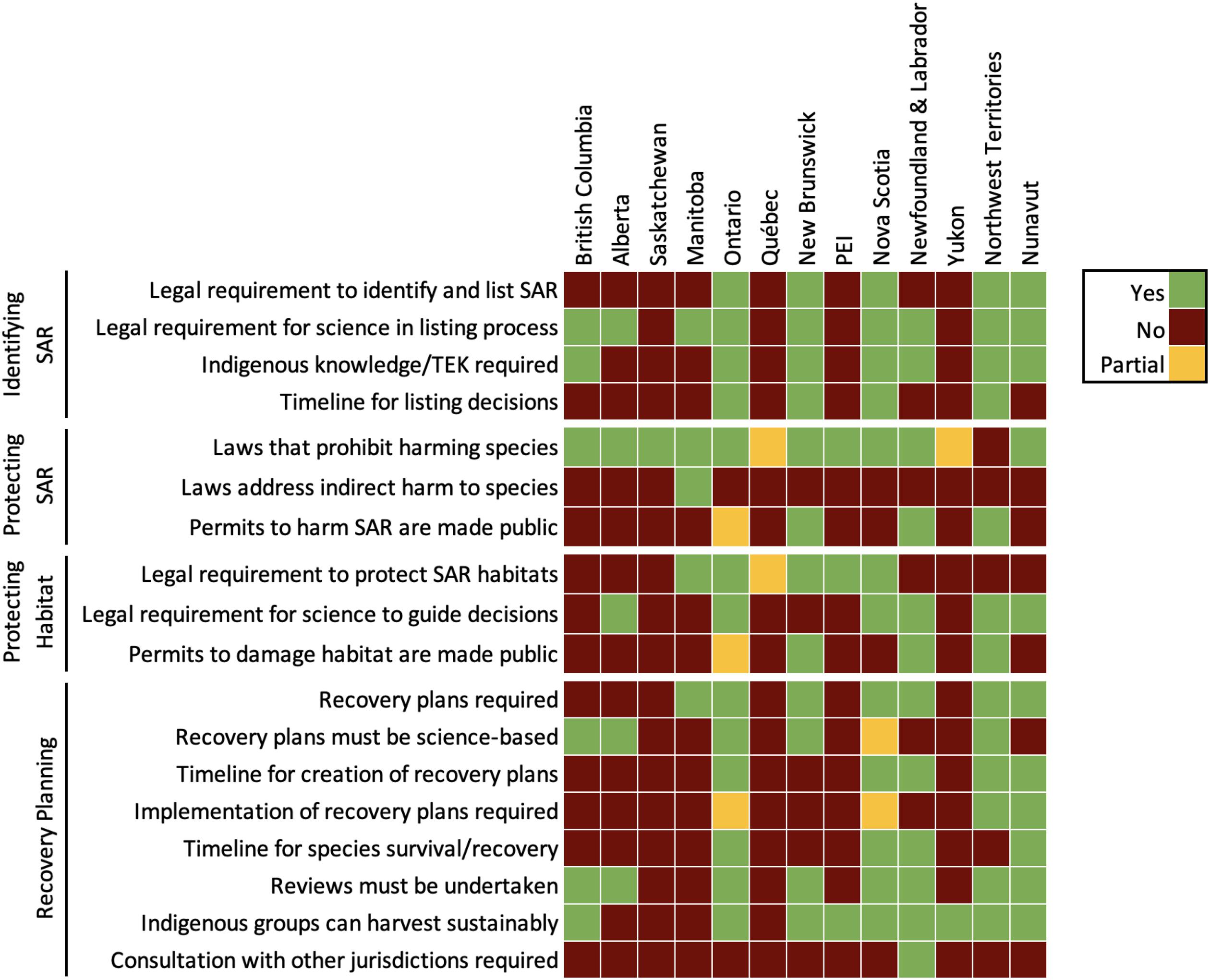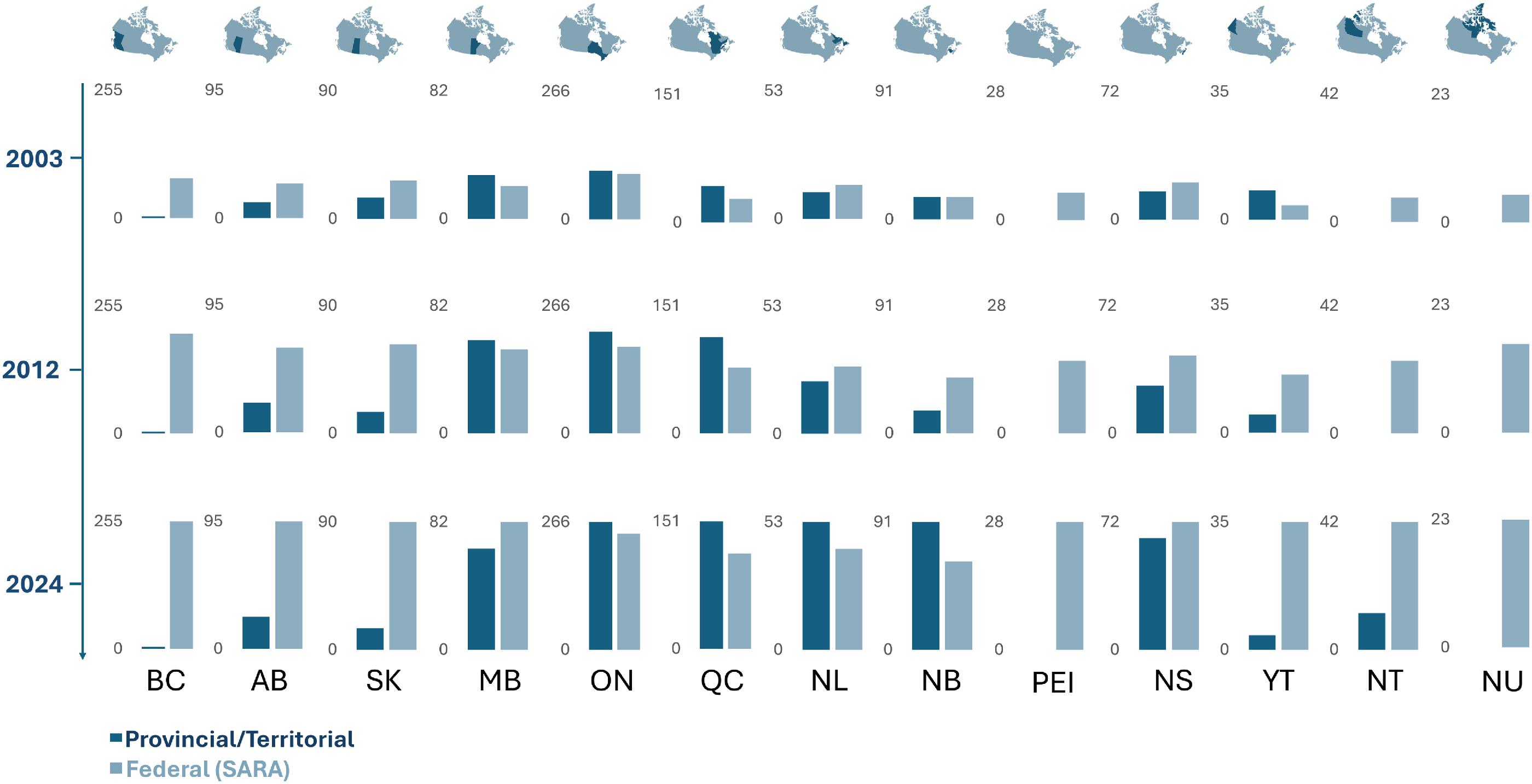Assessing species at risk legislation across Canadian provinces and territories
Abstract
Introduction
Methods

Results
British columbia
Listing process
Species and habitat protection
Recovery
Updates

Alberta
Listing process
Species and habitat protection
Recovery
Updates
Saskatchewan
Listing process
Species and habitat protection
Recovery
Updates
Manitoba
Listing process
Species and habitat protection
Recovery
Updates
Ontario
Listing process
Species and habitat protection
Recovery
Updates
Québec
Listing process
Species and habitat protection
Recovery
Updates
Newfoundland and labrador
Listing process
Species and habitat protection
Recovery
Updates
New brunswick
Listing process
Species and habitat protection
Recovery
Updates
Prince Edward Island
Listing process
Species and habitat protection
Recovery
Updates
Nova Scotia
Listing process
Species and habitat protection
Recovery
Updates
Territories
Yukon
Listing process
Species and habitat protection
Recovery
Updates
Northwest territories
Listing process
Species and habitat protection
Recovery
Updates
Nunavut
Listing process
Species and habitat protection
Recovery
Updates
Recommendations
Pursue dedicated and harmonized species at risk legislation
| Problem | Most affected provinces/territories | Recommendations |
|---|---|---|
| Species at risk regulations are dispersed among multiple acts or in acts dedicated to hunting or wildlife management | British Columbia, Alberta, Saskatchewan, Québec, PEI, Yukon, Nunavut | (1) Establish dedicated species at risk legislation encompassing all relevant taxa |
| Final listing decisions are not made by independent experts or are influenced by discretionary power | British Columbia, Alberta, Saskatchewan, Manitoba, Québec, Newfoundland and Labrador, PEI, Yukon, Northwest Territories, Nunavut | (3) Establish a fully independent committee responsible for assessing species at risk (5) Appoint members with scientific, Indigenous and traditional knowledge (2) Automatically designate species following committee recommendations and Indigenous consultation |
| Species protection and/or recovery plans are not required or are subject to discretion | British Columbia, Alberta, Saskatchewan, Québec, Newfoundland and Labrador, PEI, New Brunswick, Nova Scotia, Yukon, Northwest Territories | (6) Establish automatic prohibitions against harming listed species and their critical habitat (2) Establish recovery plan requirements for listed species |
| Timelines are not present or are not enforced (assessed only for provinces with dedicated SAR legislation) | Ontario, New Brunswick, Nova Scotia, Northwest Territories | (4) Establish enforceable timelines for key steps in the listing and recovery process for SAR (5) Limit exceptions for extensions |
| Exemptions and permits compromise species and habitat protection | British Columbia, Alberta, Manitoba, Ontario, Québec, New Brunswick, Nova Scotia, Northwest Territories, Nunavut | (5) Eliminate the use of “conservation funds” for granting exemptions (5) Limit exemptions to activities that will not place species further at risk(3) Prioritize Indigenous rights to manage their traditional territories and the species within them, and explore co-management where appropriate |
| Habitat protection is limited to public land | British Columbia, Alberta, Saskatchewan, New Brunswick, PEI, Yukon | (3) Identify critical habitat of SAR(6) Automatically protect critical habitat on public and private land(6) Encourage partnership with landowners by providing compensation and conservation incentives |
| Listing process and recovery plans are not made publicly available or are not open to public comment (assessed only for provinces with dedicated SAR legislation) | Manitoba, Québec, New Brunswick, Nova Scotia | (7) Establish a publicly accessible website with information on assessment committees, listing process, listed species, permits, and recovery plans(7) Provide an opportunity for public comment on recovery plans |
Note: Note that we consider written law only, and do not consider implementation. The numbers in brackets refer to the corresponding recommendation section in the text.
Reduce reliance on discretionary power
Embrace Western science and Indigenous rights, science, and evidence
Establish reasonable timelines
Restrict and regulate exemptions
Protect habitat on government and private lands
Commit to transparent decision-making
Conclusion
Acknowledgments
References
Information & Authors
Information
Published In

History
Copyright
Data Availability Statement
Key Words
Sections
Subjects
Authors
Author Contributions
Competing Interests
Funding Information
Metrics & Citations
Metrics
Other Metrics
Citations
Cite As
Export Citations
If you have the appropriate software installed, you can download article citation data to the citation manager of your choice. Simply select your manager software from the list below and click Download.
